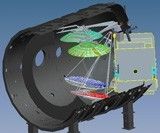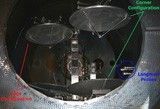
-
StatusCompleted
-
Status date2014-02-27
-
Activity Code4A.025
The EPCOMSIM study was carried out to quantitatively assess the impact of plasma plumes generated by common ion thrusters (SPT-100, PPS-1350, HEMP-T) on the RF comlink of a geostationary telecommunications satellite.
Ion thrusters offer a high specific impulse making them attractive for station keeping manoeuvres of geostationary satellites. The satellite corners are an attractive position to mount the thrusters where they fire within the field-of-view of the payload reflector antennas for an extended period of time. Instabilities within the plasma plume could modulate onto the RF carrier and in turn degrade signal quality. The impact must be known to guarantee the performance of the mission.
The objective of the EPCOMSIM study was two-fold:
- To obtain measurement results of the spurious modulation induced by a plasma plume on a RF carrier by means of representative test setups,
- To develop and validate (against measurements) a simulation tool for modelling of the plasma plume interference.
Point 1 required the development of a stable mechanical+electrical setup inside the chosen vacuum facility (IV10 of Alta in Pisa, Italy, the largest vacuum chamber available in Europe for electric propulsion testing), a RF acquisition system able to work within the highly reverberating environment inside the vacuum chamber and the RF test setups themselves.
Point 2 required the development of detailed plume models of the three test thrusters (SPT-100, HEMP-T and PPS-1350) and on the electromagnetic side the development of an EM solver tailored to the specific problem. The EM solver was integrated into the software Antenna Design Framework-ElectroMagnetic Satellite (ADF-EMS) by IDS to have an easy to use interface.
The following key issues have been addressed in the EPCOMSIM study.
Simulation activity:
- Plume modelling under unsteady boundary conditions,
- Numerical efficient EM model for the plume-wave interaction,
- Efficient modelling workflow for the user of the simulation tool.
Test activity:,
- RF acquisition system inside vacuum chamber (time gating),
- Test setup design for the basic test featuring rails to allow a ‘tomographic’ scan of the plasma plume,
- Test setup design for the advanced test featuring four reflector antennas with mechanical adjustment capability, high-frequency Langmuir probes and three ion thrusters.
The plasma induced EM interference is a complex phenomenon depending on many parameters. The simulation tool has been developed and validated against the extensive measurement results and is the first tool on the market able to simulate the effect.
The simulation tool allows satellite manufacturers to optimise the spacecraft design i.e. placement of the ion thruster with respect to the payload reflector antennas deriving preferred and/or stay-out zones. Up to now a thruster placement with firing through the reflector antennas field-of-view has generally been avoided. The tool offers the opportunity to investigate optimized configurations.
The tests were carried out in two parts:
- Experiments for basic evaluation of the interference effect (called basic setup): horn-to-horn measurements through various parts of a plasma plume (two test campaigns with SPT-100 and PPS-1350 thrusters),
- Verification of the SGEO configuration (called advanced setup): flight-representative setup of the SGEO satellite with respect to reflectors, thrusters, geometry (single test campaign with all three thrusters).
The advanced test setup was derived from two spacecraft configurations: the baseline configuration consisting of one large side-deployable reflector and an alternative configuration for multispotbeam missions with two medium-sized reflectors. The experimental setup was designed to cover both configurations.
Vacuum chamber accommodation of the experimental setup (left) and photograph of the advanced test setup (right)
 click for larger image |
 click for larger image |
The largest reflector of the SGEO mission was chosen for the test setup. The reflector-to-thruster geometry is fully representative of the actual satellite design. In order to have a direct comparison between both configurations the reflector diameter is identical. The test setup is shown in the figure (the satellite body is added for clarification purposes). In order to measure inside the vacuum chamber each reflector has been paired with a second collecting reflector of prime-focus type. Each reflector pair forms a ‘beam waveguide’ system where the upper reflector collects almost all of the beams from the lower reflector. This maximizes the signal-to-noise ratio (SNR) and minimizes the energy coupled to the chamber. High-frequency Langmuir probes have been added as further diagnostic tool.
The simulation activity was carried out as follows:
Fitting functions for the stationary plumes are derived from the input of the thruster manufacturers (Snecma and Thales Electron Devices). The instability mode is modelled analytically. The EM modelling scenario is based on a quasi-static approach (the RF signal is much faster than the plume instability) and a non-invasive plume condition (the plume density and its gradients are negligible in close vicinity of relevant radiating elements). The computation uses the equivalence principle where the plume is replaced by equivalent Huygens sources. The equivalent surface can be chosen according to the plasma permittivity and its gradient. A dedicated scheme called phase-front model has been developed to accelerate the computations within an iterative physical optics (PO) paradigm. The modelling tool has been integrated into the ADF-EMS where a dedicated modelling procedure allows the user to define the plasma plume parameters and its installation in the spacecraft model conveniently.
Phase 1 Tool Development and Demonstrator Manufacturing:
- Model Definition and Testing (Progress Meetings 1+2),
- Analytical EM Propagation Model (Modelling Review),
- Simulation Tool Assembly (Simulation Tool Review),
- Demonstrator Design+ Manufacturing (Exp. Demonstrator Review),
- Dry Run Test in (Open) Vacuum Chamber (RF Chain).
Phase 2 Test Campaigns:
- Basic Test #1 and #2,
- Progress Meeting 3,
- Advanced Test,
- Comparison Measurements and Simulations (Post Test Review).
The EPCOMSIM study was completed in March 2012. All objectives have been reached.




